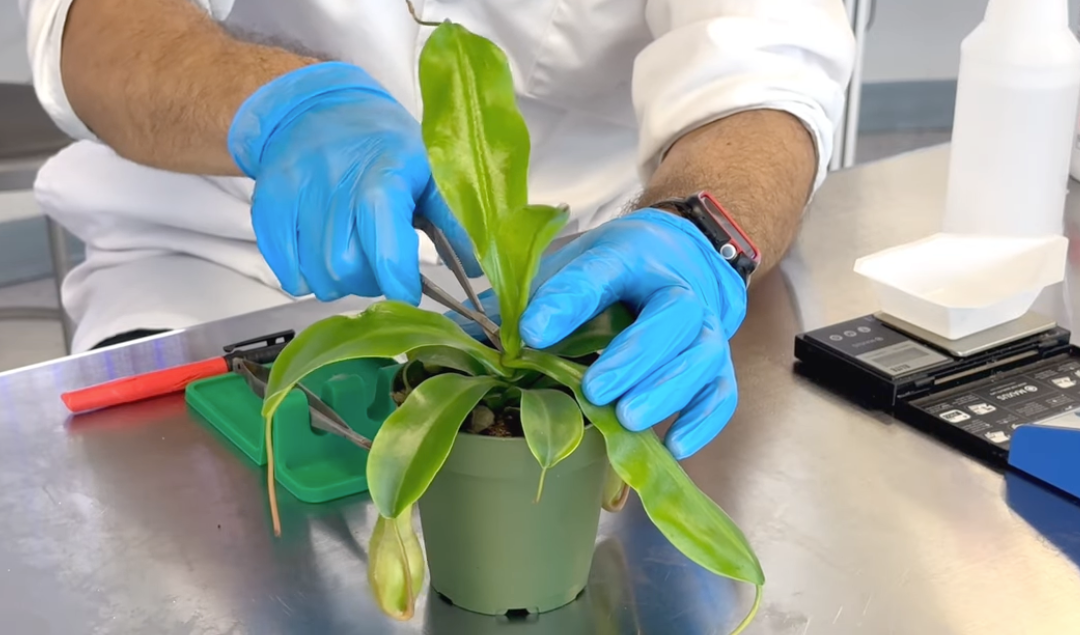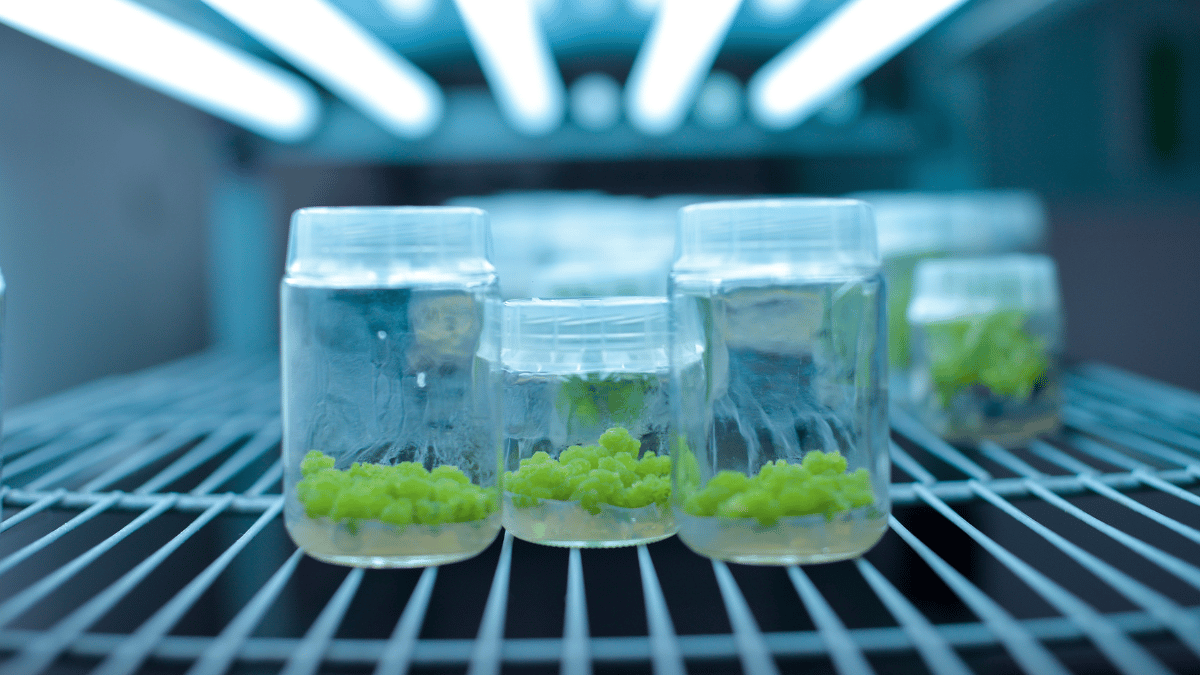
Get the Protocol: How to Tissue Culture Nepenthes Using Nodes and Seeds

Introduction
This plant is non-vegeterian...
...and we're not kidding!
Nepenthes belongs to one of the most interesting families of carnivorous plants. The Nepenthes genus comprises around 160 species.
Spread across Southwestern Asia, while dominating Borneo and Sumatra, these fascinating botanical wonders are renowned for their unique adaptation: modified leaves transformed into ingenious pitcher-shaped traps.
These specialized structures exhibit remarkable diversity. Nepenthes species range in size from petite, jewel-like epiphytes with delicate pitchers holding mere drops of fluid to towering giants boasting pitchers capable of entrapping small animals and holding liters of liquid.
The pitchers are a testament to the intricate interplay between plant physiology and ecological strategy. Their captivating peristome colors, ranging from vibrant reds and oranges to alluring purples and blacks, often adorned with intricate waxy ridges, floral scent, and nectar secretions, serve as a visual lure for unsuspecting insect prey.
These visual cues are complemented by the production of fragrant volatile compounds, further enticing their victims.
The pitcher's slippery rim and inward-pointing hairs act as a treacherous path for insects drawn to the visual and olfactory enticements. Once inside the pitcher's cavity, the viscoelastic liquid containing hydrolytic enzymes in the pitcher breaks down captured prey, providing essential nutrients for the plant in nutrient-poor tropical environments.
Nepenthes thus exhibit a fascinating example of carnivory, a unique nutritional strategy that evolved to overcome the limited availability of nitrogen and other minerals in their native habitats.
In this article we cover more about the propagation techniques used to cultivate Nepenthes and a step-by-step procedure to introduce the plant in tissue culture using two explants: nodes and seeds.

Nepenthes Value and Growing Techniques
Some Nepenthes varieties have various medicinal properties, such as anti-osteoporotic, antimicrobial, and antioxidant properties. Traditionally, extracts from these plants have been used to manage blood sugar and cholesterol. They are also being explored for their potential application in eye drops for cataracts and night blindness.
Beyond their captivating appearance, Nepenthes offer practical uses. The open pitchers have served as natural water carriers and cooking vessels, while the vines have been utilized for cordage. Additionally, these fascinating plants are cultivated for their ornamental value.
Nepenthes propagation presents several options, including seeds, stem cuttings, air layering, and ground layering. However, it was a wild goose chase as they didn’t obtain satisfying results.
Sexual propagation using seeds faces challenges due to separate male and female flowers on individual plants, which can potentially hinder successful pollination.
Vegetative propagation methods like cuttings and layering, while viable, can be slow and yield inconsistent results.
This demanded an advanced approach—the tissue culture technique — that could multiply these plants commercially and preserve their genetics.
This in vitro technique allows rapid production of large numbers of uniform plants in a controlled environment. The benefits of tissue culture extend beyond efficiency. It serves as a valuable tool for conservation efforts by reducing dependence on wild populations and helping to replenish declining Nepenthes populations in their natural habitat.

Nepenthes Tissue Culture Protocol: From PCT Lab
This protocol is what we follow in our lab. And, in our effort to make tissue culture more accessible we are sharing this here with you. This blog is based on our latest video about "How to Tissue Culture a Carnivorous Plant", which you must watch to learn accurately about the explant cutting process.
Multiplication Media Preparation For Explants
- Take 800ml distilled water and and 1.5 grams MS (⅓ MS), 25 grams sucrose, and1.0 mg BAP for 1 liter of the media. Keep the jar on a magnetic stirrer to mix all the components.
- Turn off the magnetic stirrer and make it up to 1 liter.
- Add 3 grams gellan gum.
- Close the jar, making sure it's not tight
- Place this in the pressure cooker to sterilize for 25 minutes at about 250° Fahrenheit or 121° C or 15 psi.
Media Preparation For Seeds
For 250 ml Media
- Take 200 ml distilled water then add 5 grams sugar directly to the bottle. For 1-liter media multiply everything by 4)
- Next, add MS media containing micro and micronutrients and vitamins for plant growth. Carnivorous plants grow in poor nutrient conditions, so 1/3 MS media is generally recommended for explants. However, for seeds, you need about 0.3 to 0.4 g for 250 ml.
- Add 1 ml per liter PPM to the media to prevent contamination.
- Turn off the magnetic stirrer and add the rest 50 ml of the water.
- Adjust the pH between 5.4 and 5.8, which is slightly acidic. After calibrating the pH, add the gelling agent.
- You need 8 g of agar for 1 liter of media, so for 250ml you need to add 2 g of agar. Once you've added the agar, your media will be ready!
- Close the bottle, making sure it's not tight
- Place this in the pressure cooker to sterilize for 25 minutes at about 250° Fahrenheit or 121° C or 15 psi.
AGAR Vs. GELLAN GUM FOR CARNIVOROUS PLANTS
NOTE: You need to use hydrogen peroxide for the seed sterilization method. So, we will have residual hydrogen peroxide in the medium because we're going to transfer the plant directly from the hydrogen peroxide to the medium.
The hydrogen peroxide can precipitate the gellan gum, turning the gel back into liquid. This will be one of those special cases where we must use agar instead of gellan gum as it precipitates the media.
Also,Gellan gum does indeed require calcium ions (Ca2+) for proper gel formation. But, for Nepenthes seed culture we are using a ¼ strength MS. This means we have a reduced amount of calcium, which can make the gellan gum not solidify or maybe be softer than it would normally be.
When you use ⅓ MS media, you can use gellan gum as it's like really clear. But when we use ¼ MS, prefer agar because it's going to solidify perfectly.
Explant Cutting
- Clean your scissors with isopropyl alcohol, ensuring a sterile environment for our plant manipulation.
NOTE: If I were working with more virus-susceptible plants, I'd use bleach to clean my tools instead of 7% alcohol. You can also use heat, like a glass bead sterilizer or a lighter, to ensure they're clean and sterile.
- Dry this up using a paper towel.
- Cut the leaf of the plant from the bottom so you have nodes in it.
- Take the top cut, as you don't need the complete leaf. So, just cut it away.
- Trim the end and the edges of the leaf.
- Remove as many tissues as you can, but make sure not to get to the meristem at the very tip.
- Put the nodes in the jar and add Sodium dichloro
- Close the jar, flip it a few times upside down, and shake it for just a few seconds, so you are also sterilizing the part of the cap and everything that is not in contact with the Sodium dichloro.
- Sterilize the plant for 24 hours on an orbital Shaker.
Explant sterilization
- Add 1 liter of water in beaker and turn on the magnetic stirrer
- Take ½ grams of sodium dichloro-s-Triazinetrione dihydrate and add it to the same beaker.
- Add 1-2 drops of tween-20.
- In the jar with collected explants, add the prepared sterilizing solution (fill the jar completely).
- Put the cap on and shake it gently (up and down; up and down–that’s it!).
- Put the jar on an orbital shaker for overnight.
- Cut the explant to the desired size and rinse in sterile distilled water.
- Transfer the explant to the prepared media.
- Ensure your explants make good contact with the media (without submerging them completely in it).
Seed sterilization
- Take 3% hydrogen peroxide (you can purchase it from the grocery store). It works great for all of the other seeds.
NOTE: You need to work with very fresh seeds. They have a very short fresh life. Hydrogen peroxide adds oxygen to seeds, which is essential for the seeds to sprout.
- To prepare the solution, combine 1 milliliter of hydrogen peroxide and 19 milliliters of water to create a 20 ml solution. Also, add one drop of Tween-20.
- Place the seeds in test tubes.
- Fill the tube with the prepared sterilization solution for sterilization.
NOTE: Old seeds may require a bit of sugar in the solution for energy to sprout.
- The seeds are left overnight in the solution, which will be replaced with sterile water the next day.
Pouring Media
- Spray the Petri dish, jar, and hood surface with alcohol before starting your work.
- Pour the prepared media into Petri dishes, carefully examining cleanliness and sterility.
- After solidifying for about 10 minutes, the dishes are sealed. Your plates are ready for use in experiments the following day.
Transferring Explant to The Media
- Spray the glass jar containing the explant with sterilization solution.
- Take a Petri dish and pour some disodium chloro into it.
- Take out the explant from the jar and keep it in the petri dish.
- Using a scalpel and blade remove any dead tissues, without damaging the meristem.
- Transfer the explant to a jar containing sterile distilled water and give it a shake.
- Remove the explant from the water and place it on the prepared explant media. Place it right in the center of the media. Ensure it's facing up, and don't go too deep.
NOTE: Normally when we start cultures we start on test tubes for smaller containers. The only issue working with the bigger container is that if itgets contaminated, then you lose the entire medium, which is a little bit more wasteful. If you have a test tube, you only use a very small amount of media, so you don't waste as much.
Transfer Seeds To The Media
- Remove seeds from the hydrogen peroxide
- Place them in the media containing 1/4 the strength of full MS, 30g of sugar, and no hormones.
Plant Cell Technology: Your Partner In Plant Tissue Culture
Are you passionate about plants and fascinated by the potential of plant tissue culture? Plant Cell Technology understands your aspirations and is here to be your trusted partner in building a thriving home lab.
We recognize that setting up a home lab and mastering the intricacies of plant tissue culture can be challenging. However, with the right tools, knowledge, and support, you can cultivate success and unlock a world of possibilities.
How Plant Cell Technology Empowers You:
- Essential Supplies: Access a comprehensive range of high-quality media, agar, gelling agents, culture vessels, and more, ensuring you have the right tools for every step.
- Expert Knowledge: Gain confidence through our informative resources:
- Comprehensive blog articles: Explore topics from basic principles to advanced techniques.
- Master Classes: Immerse yourself in in-depth sessions led by experienced instructors, gaining valuable hands-on experience and mastering advanced techniques.
- Consultation Services: Get personalized advice and tailored solutions from our experts, ensuring your home lab journey flourishes.
- Community Connection: Join our vibrant community forum to connect with fellow enthusiasts, share experiences, and stay updated on the latest advancements.
Blog Categories
View by Level
Popular Blogs

Callus Culture: Definition and Applications
Introduction Tissue culture is not just one technique! Yes, you heard right! As you know, tissue culture is an advanced...
Read More
6 Plant Tissue Culture Books to Keep Learning
Introduction Most of us are fans of books when it comes to learning a topic in detail and in a...
Read MoreSubscribe to Our Newsletter










Join the conversation
Your email address will not be published. Required fields are marked